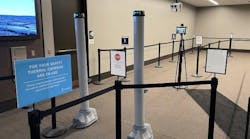Software updates. Seat upgrades. Self-improvement. So much of what we experience in our lives is subject to reinvention. Except, it often seems, security measures.
Too often when we walk into a venue, we experience the same checkpoints we’ve encountered for years. Security personnel operating metal detectors and manually wanding visitors was never the ideal solution, and it’s even less so now. Security standards are not keeping pace with advances in other parts of society. Here’s why we need a new standard in security.
Airlines Set a Standard
It’s important to start by understanding the past because threats have changed over the years. It’s modifying our response to them that hasn’t kept pace. Through the 1960s and early 1970s, there were dozens of plane hijackings that occurred on flights originating in the U.S. In 1972, following five hijackings in a single week, the government took action. The Federal Aviation Administration created rules mandating all passengers undergo security screening prior to boarding a flight.
The technology that was put in place was developed for maximum-security prisons and certain sensitive military facilities – walk-through metal detectors and x-ray machines. This was not technology that had been designed for the kind of high-throughput airports experience. It was simply the technology that was available at the time.
While metal detectors have become more sophisticated in discerning smaller amounts of metal, and the quality of images that x-ray machines produce has improved, fundamentally, the technology has not changed in more than 50 years.
Airlines have adapted in certain ways over the years in response to different threats. Following the explosion of Pan Am Flight 103 over Lockerbie, Scotland, in 1988, U.S. airlines implemented positive passenger bag match, thinking that as long as the owner of a bag was on an aircraft, the bag didn’t need to be screened because people wouldn’t blow up a flight they were on. That screening process was in review and scheduled to be finalized in October 2001, but the Sept. 11 attacks changed that thinking. The TSA was formed in response to Sept. 11, and subsequent threats resulted in additional changes to security. After the shoe bomber was caught, passengers needed to remove their shoes at airport security, and full-body imaging was installed in 2009 after the underwear bomber was caught.
Unfortunately, other industries have not been as responsive as aviation has when it comes to security standards.
Problems Worsened by Current Standards
We have settled into a cycle where the security industry takes available technology and applies it to solve a current problem, even though that solution was never designed to handle the situation – whether that’s the size of crowd it is being used with or what people currently carry around in their pockets.
Over the years, metal detectors have gotten very good at detecting metal. Most people entering a given venue, though, are carrying increasing amounts of metals in their pockets. From cellphones, to tablets and wireless headphones, there are more items than ever that we carry with us daily that can trigger metal detectors. These false alarms require additional security personnel, entry delays and unhappy guests.
Bottlenecks at a security check create an entirely new security threat outside a venue. And false alarms, or nuisance alarms, can exhaust security teams. Far more people set off a metal detector due to “pocket clutter” items than for actual threats, and the more time personnel spend on false alarms, the less likely they are to spot a weapon.
Setting a New Standard
The types of venues that employ metal detectors are private entities. Hospitals, arenas, performing arts centers – those are not the types of venues that are federally mandated. There is a desperate need for security standards that places like these can follow that reflect what people actually carry and what poses a real threat. What could the new standard of security look like?
- Identify the real threats of concern: Technology has advanced beyond simply identifying metal. We know exactly what we’re looking for at a security checkpoint: weapons. Instead of a metal detector, venues should use technology that can identify specific threats rather than the everyday clutter items we carry in our pockets and bags.
- Technology needs to be simple to use: The technology needs to be “red light-green light simple” to operate. In many cases, the people who are operating security checkpoints are doing so for eight hours a day. They need to be alert during that time, and focused on potential threats, not how to operate a complicated piece of technology.
- New systems need to work with existing security measures: A system that can quickly identify threats doesn’t do much good if it can’t seamlessly interact with technology that already exists at a venue. Security cameras, for example, can be incorporated to integrate with the new technology, rather than operating independently. A notification process needs to be quick and easy as well, so that all security personnel are aware of threats immediately and simultaneously.
Technology has advanced, and threats have evolved. There is no need for security standards to be stuck decades in the past. We need to challenge our assumptions about what the real threats are and do more to protect against them. We need to set a new standard that does more to keep people safe.
About the Author:
Mike Ellenbogen is Evolv Technology’s co-founder and chief innovation officer. Evolv Technology is dedicated to making the world a safer place with technology that enhances safety without sacrificing the visitor, student, and employee experience.



